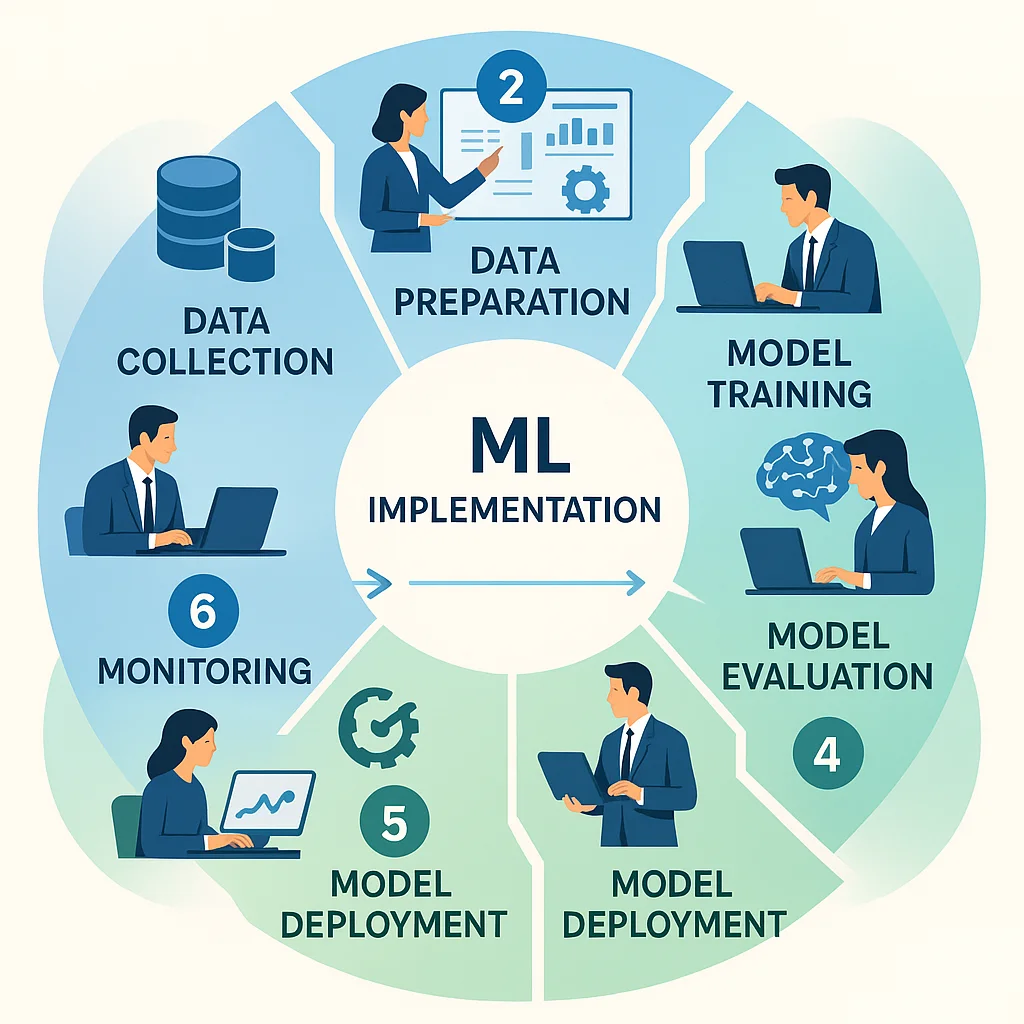
From Theory to Practice: Your ML Implementation Journey
Machine learning has evolved from a niche technology to a business imperative. Organizations are discovering that ML transforms how businesses operate, make decisions, and create value for customers.
What Machine Learning Means for Business
Machine learning enables systems that can:
- Predict outcomes based on historical data
- Automate complex decisions at scale
- Discover patterns humans might miss
- Adapt and improve over time
The Business Value Proposition
Companies implementing ML successfully report:
- 15-30% increase in operational efficiency
- 20-40% improvement in decision-making speed
- 25-50% reduction in manual processing time
- 10-25% increase in customer satisfaction

Common Machine Learning Use Cases by Industry
Financial Services
- Fraud Detection: Real-time transaction monitoring
- Credit Scoring: Automated risk assessment
- Algorithmic Trading: Market prediction and execution
- Customer Service: Intelligent chatbots and support
Healthcare
- Medical Imaging: Diagnostic assistance and analysis
- Drug Discovery: Compound identification and testing
- Patient Monitoring: Predictive health analytics
- Treatment Optimization: Personalized medicine
Retail & E-commerce
- Recommendation Systems: Personalized product suggestions
- Inventory Management: Demand forecasting and optimization
- Price Optimization: Dynamic pricing strategies
- Customer Segmentation: Targeted marketing campaigns
Manufacturing
- Predictive Maintenance: Equipment failure prevention
- Quality Control: Automated defect detection
- Supply Chain Optimization: Logistics and planning
- Production Planning: Demand-driven manufacturing

The ML Implementation Framework
Phase 1: Discovery and Assessment (2-4 weeks)
Key Activities:
- Identify specific pain points ML can address
- Define success metrics and KPIs
- Inventory available data sources
- Evaluate data quality and completeness
- Assess organizational readiness
Phase 2: Strategy and Planning (2-3 weeks)
Key Activities:
- Design ML system architecture
- Select appropriate algorithms and approaches
- Create detailed implementation timeline
- Establish governance and oversight
- Develop risk mitigation strategies
Phase 3: Data Preparation (4-8 weeks)
Key Activities:
- Gather data from various sources
- Handle missing or incorrect data
- Normalize and standardize formats
- Create new features from existing data
- Prepare data for model training
Phase 4: Model Development (6-12 weeks)
Key Activities:
- Choose appropriate ML algorithms
- Train models using prepared data
- Test against validation datasets
- Measure accuracy and performance metrics
- Optimize for production deployment
Phase 5: Deployment and Integration (3-6 weeks)
Key Activities:
- Deploy models to production environment
- Integrate with existing business systems
- Train end users on new capabilities
- Implement monitoring and logging
- Test end-to-end functionality
Phase 6: Monitoring and Optimization (Ongoing)
Key Activities:
- Track model accuracy and performance
- Monitor system health and availability
- Regular model retraining and updates
- Performance optimization
- Expansion to new use cases
Key Success Factors
1. Executive Sponsorship and Leadership
- Strong leadership commitment and vision
- Clear strategic alignment with business goals
- Adequate resource allocation and budget
- Change management support
2. Data Quality and Governance
- High-quality, clean, and relevant data
- Robust data governance frameworks
- Proper data security and privacy measures
- Scalable data infrastructure
3. Technical Expertise and Team
- Skilled data scientists and ML engineers
- Domain experts and business analysts
- Strong project management capabilities
- Continuous learning and development
Common Pitfalls and How to Avoid Them
1. Poor Problem Definition
Pitfall: Vague or unrealistic expectations
Solution: Clearly define specific business problems and success metrics
2. Insufficient Data Quality
Pitfall: Using poor quality or irrelevant data
Solution: Invest in data quality assessment and improvement
3. Lack of Business Alignment
Pitfall: Technical solutions without business context
Solution: Involve business stakeholders throughout the process
Measuring Success and ROI
Key Performance Indicators
Technical Metrics
- Model accuracy and precision
- System performance and latency
- Data quality scores
- Uptime and availability
Business Metrics
- Cost savings and efficiency gains
- Revenue impact and growth
- Customer satisfaction improvements
- Process automation rates
ROI Calculation Framework
ROI = (Benefits - Costs) / Costs × 100
Benefits:
- Operational cost savings
- Revenue increases
- Risk reduction value
- Efficiency improvements
Costs:
- Technology and infrastructure
- Personnel and training
- Implementation and maintenance
- Opportunity costs
Getting Started: Your Next Steps
- Assess Your Readiness
- Evaluate current data and technology capabilities
- Identify specific business problems to solve
- Assess organizational readiness for change
- Start with a Pilot Project
- Choose a well-defined, high-impact use case
- Ensure data availability and quality
- Set realistic expectations and timelines
- Build Your Team
- Identify internal champions and stakeholders
- Recruit or train necessary technical talent
- Establish governance and oversight
- Partner with Experts
- Consider working with experienced ML consultants
- Leverage external expertise for complex projects
- Accelerate time to value with proven approaches
Conclusion
Machine learning represents a transformative opportunity for businesses across industries. Success requires careful planning, strong leadership, quality data, and the right team.
Key Takeaways:
- Start with clear objectives and business alignment
- Invest in the right capabilities and infrastructure
- Maintain focus on business value over technical complexity
- View ML as strategic business transformation, not just technology
The organizations that succeed will be those that approach machine learning as a strategic business transformation that unlocks new possibilities and drives sustainable growth.
Ready to start your machine learning journey? Contact our ML experts to discuss your specific needs and develop a customized implementation strategy for your business.
